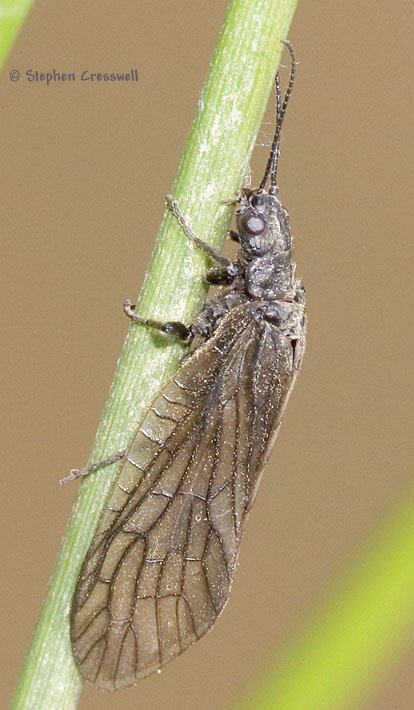
Family: Sialidae
Length: typically 13-18 mm
When it comes to identifying West Virginia Alderflies, the good news is that there is only one genus in the state (and, in fact, only one in all of North America), and that is Sialis. Thus the genus is a given, but unfortunately separating the various species of Sialis typically is not an easy matter.
Gatewood and Tarter (1983) studied the life history of Sialis aequalis along Flatfoot Creek in Mason County. Females of the species laid an average of 657 eggs each, usually on the underside of leaves that were over the water, or near the water. Eggs hatched at the study location in mid to late May. The aquatic larvae developed over 10.5 months, and the authors noted that the species apparently is univoltine.
Gatewood and Tarter found the larvae were overwhelmingly detrivores. Only occasionally did larvae supplement their diets with other food sources such as alga filaments, diatoms, and midge larvae.
A drawing of a nymph of Sialis infumata is elsewhere on this site.
At the end of the larval period, the final instar larvae emerge from the water and constructed earthen pupal chambers along the stream bank.  While pupation was difficult to study in the field, in the laboratory the pupal period lasted 10-22 days. Along the creek, adults were present from April 25 to May 10. Adults appeared not to feed.
While pupation was difficult to study in the field, in the laboratory the pupal period lasted 10-22 days. Along the creek, adults were present from April 25 to May 10. Adults appeared not to feed.
In another study, Tarter and Woodrum (1972) studied Sialis aequalis at a creek that, unlike Flatfoot Creek, did not have clean water. The study site, Camp Creek in Wayne County, had considerable acid mine drainage, and yet Sialis aequalis seemed to do well there. Data from other studies confirm that Alderfly larvae do reasonably well in the presence of acid mine drainage.
Other life history studies of Sialis spp. (for example, Locklin et al., 2006; and Barrows et al. 2005) turned up similar data. Some researchers found less feeding on detritus and more feeding on annelid worms, midge larvae, and tiny crustaceans (Ostracods).
Hayashi (1999) studied mating of Alderflies. As in other Megaloptera, the males attach a spermatophore to the tip of the females abdomen. Hayashi found that Alderfly copulation lasts less than two minutes, while in another Megaloptera group, Fishflies, copulation lasts two to six hours. Hayashi found that in Alderflies, the sperm leave the spermatophore relatively quickly, and prolonged mating isnt necessary. In Fishflies, the spermatophore is emptied slowly, and males have evolved to prolong copulation to ensure their sperm are successfully transferred to the female.
West Virginia is home to seven species in family Sialidae, and they are listed at the bottom of this page along with maps indicating which counties have reported which species. These maps are based on published data by Tarter and co-authors, and species identification by an expert on the genus.
This is both the genus page for Sialis and the family page for Sialidae
Insects of West Virginia








